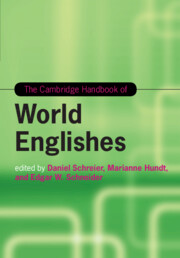Book contents
- The Cambridge Handbook of World Englishes
- Cambridge Handbooks in Language and Linguistics
- The Cambridge Handbook of World Englishes
- Copyright page
- Dedication
- Contents
- Figures
- Maps
- Tables
- Notes on Contributors
- 1 World Englishes: An Introduction
- Part I The Making of Englishes
- 2 The Colonial and Postcolonial Expansion of English
- 3 Theoretical Models of English as a World Language
- 4 The Contribution of Language Contact to the Emergence of World Englishes
- 5 Population Structure and the Emergence of World Englishes
- 6 World Englishes, Migration, and Diaspora
- Part II World Englishes Old and New
- Part III Linguistics and World Englishes
- Part IV Current Challenges
- Index
- References
6 - World Englishes, Migration, and Diaspora
from Part I - The Making of Englishes
Published online by Cambridge University Press: 16 December 2019
- The Cambridge Handbook of World Englishes
- Cambridge Handbooks in Language and Linguistics
- The Cambridge Handbook of World Englishes
- Copyright page
- Dedication
- Contents
- Figures
- Maps
- Tables
- Notes on Contributors
- 1 World Englishes: An Introduction
- Part I The Making of Englishes
- 2 The Colonial and Postcolonial Expansion of English
- 3 Theoretical Models of English as a World Language
- 4 The Contribution of Language Contact to the Emergence of World Englishes
- 5 Population Structure and the Emergence of World Englishes
- 6 World Englishes, Migration, and Diaspora
- Part II World Englishes Old and New
- Part III Linguistics and World Englishes
- Part IV Current Challenges
- Index
- References
Summary
This chapter discusses the relevance of language contact in smaller-scale migration and linguistic diaspora situations for the study of World Englishes (WEs). It provides definitions of the terms diaspora and diasporic language variety and establishes a practice-oriented view of language use that acknowledges the speakers’ linguistic agency in constructing social meaning. It explores intersections of WEs with sociolinguistic identity construction (1) by attempting to bridge the gap between language mixing and WEs research; (2) by problematizing the role of the immigrant generation in the use of ethnolinguistic features; (3) by teasing apart factors on language contact in multiple migration scenarios; and (4) by highlighting the relevance of urban multi-ethnolects for WEs. Contextualizing WEs studies with these different theoretical perspectives pushes the boundaries of the discipline toward foregoing essentialist categories (such as “varieties” or “ethnolects”) in favor of more fluid concepts (such as “processes,” “practices,” or “repertoires”). The chapter thus uses concepts from migration and diaspora studies to show their benefit for future research of WEs.
Keywords
- Type
- Chapter
- Information
- The Cambridge Handbook of World Englishes , pp. 120 - 142Publisher: Cambridge University PressPrint publication year: 2020
References
- 3
- Cited by

